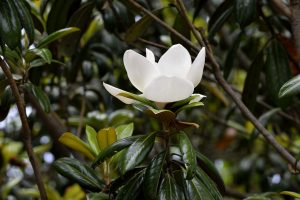Last Updated on April 10, 2024 by Real Men Sow
To create privacy and division in your garden, you can use tall plants for screening. Screening plants that grow quickly can be used to increase the height of your garden, plant alongside existing fencing, and prevent intruders. They also provide privacy, which is perhaps the main reason you should consider planting screening plants. You have a wide range of tall screening plants you can choose from. They will quickly grow and fill in any space available.
10 Best Tall Plants For Screening
Dogwood (Cornus) Trees
Dogwood is both a tree and a shrub. It is well-known for its stunning white flowers and minimal maintenance requirements. However, it is also popular for its bright stems in winter. You can use Dogwood as part of your garden screening. There are many varieties, from single-trunked trees and small shrubs to choose from. There are three main types: Cornelian cherry dogwood, Pagoda, and flowering dogwood. They all thrive in partial shade, but they can be cultivated in full sun if you give them enough water.
Dogwoods can grow up to 30 cm per year. A single tree can reach maturity in ten years. Different varieties bring a variety of colours to your garden, including bright pink, pale pink, white and pale red bracts. Dogwoods are a stunning choice of colour throughout the year. The leaves change colour from a pale pink shade to a deep red-purple shade in Autumn. This helps to keep the stems looking stunning in winter, as the browning of the branches can cause them to lose their vibrant colours.
Prunus Laurocerasus (Cherry Laurel)
Cherry Laurel is a spreading shrub that bears long dark green leaves. It can grow up to 15cm. The flowers are able to produce a wide range of beautiful colours and a strong plum fragrance. Racemes are formed during summer to produce flowers that eventually bear red fruits. In Autumn, the shades turn purple-black. These are not fruits that you should eat but they will attract a variety of birds to your garden.
This shrub is fast-growing and can be used as privacy screens in your garden. It is also commonly used for hedging and sold under the name of laurel hedge. The plant will grow to between 4-12 metres in height, with a spread outward tendency that is greater than its upward movement. It can thrive in partial shade, full sun, and soil that is well-drained. It can be pruned after the blooms have finished, but other than that, it requires very little care. If left unpruned, this screen is a great option.
Fargesia Murielae Bamboo
This variety is known as umbrella bamboo because of its unique shape and design. It can reach an average height of 4 meters and produces tightly-grown groups of bamboo stems due to its clumping spreading method. When it is grown for screening, it should be placed about 1.5m apart. However, it will quickly fill any space between them. Because of its growth habits, hundreds of canes will grow out of any given area. It avoids the problem of bamboo’s V-shaped growth, which is why it provides a more upright grove for screening than other varieties.
This bamboo is thick and requires partial shade. It can withstand the harshest conditions that bamboo can be exposed to. The leaning canes can be cut to 20% every June, and the plant will grow back straight and healthy the next year. It can also be used as screening when it is planted in larger pots.
Cypress Trees For Screening
Cypress trees come in many varieties, over 130 species to be exact, which means there is sure to be something for your garden. The leaves range in colour from a silver-green to dark green. They grow in whorled patterns or spirals and handle just about any soil type. Most people think of cypress trees and tall narrow trees but many varieties such as Thuja Plicata as pictured above are wider and make excellent screens if spaced and trimmed a couple of times a year.
Elaeagnus x ebbingei (Silverberry)
There are over 130 varieties of Cypress trees, so there’s sure to be one for you. The leaves can be either silver-green or dark green. They can grow in spirals or whorled patterns and can handle almost any type of soil. While most people associate cypress trees with tall narrow trees, many varieties of Thuja Plicata are much wider and can be used as screens. They can also be spaced out and trimmed once a year.
 Magnolia grandiflora
Magnolia grandiflora
This magnolia variety is one of the most resilient, especially in severe winter weather. This tree can reach up to 25m in height and spread out between 10 and 15 meters. However, it is also able to thrive in large pots. These can be used to screen larger properties, especially around the perimeter of your property. They also look great in bloom. The tree can be grown in full sun, partial shade, and moderate watering. It is most well-known for its fragrant, showy flowers that bloom white between May and June.
This tree is characterized by large, white flowers and dark green leaves. It blooms in spring and summer with some additional blooms throughout the year. The flowers will eventually produce fruiting clusters in early autumn. This Magnolia is more versatile than most others, and it’s also an evergreen variety that makes it great for screening. It provides coverage all year.
Photina Red Robin Plants For Screening
The broadleaf evergreen can grow up to 4 m in height and spread out between 3 and 4 m. These evergreen blooms showy, fragrant white flowers in the spring. If you are looking for a screening option that is also aromatic, this is a good choice. It thrives in moist soil, medium moisture, and well-drained soil. You can grow it in full sun, but it won’t have the same floriferous qualities. You can trim it once the reddened growth has begun to fade in spring. This will allow for better air circulation, especially in winter.
The plant is known for its rapid growth and red tips which complement the evergreen colour. The bright red spring leaves and the serrated edges that form from the new growth turn into rich evergreens. This gives the plant a variety of leaf colours. The white flowers, which are found in April, have a Hawthorn-like fragrance. You can prune the flowers in spring if you don’t want the scent but still want the red and the green leaves.
Ceanothus Concha (California Lilac)
This plant, commonly known as the California Lilac is great for screening plants and adding a little flair to your garden. These flowers are rich in lilac blues and purples, which will make a vibrant screen. They are beautiful from afar, with a stunning display of tiny, cotton-like clusters. They are even more impressive up close. The flowers are so abundant in spring that they don’t seem to notice the greenery beneath. If you live in an area with deer, this shrub can bring butterflies, birds, bees, and other beneficial insects to your garden.
It can grow to 120-240cm high and spread out to 180-360cm. Your shrub will grow larger if your climate is milder. It likes full sun and well-drained soil.


